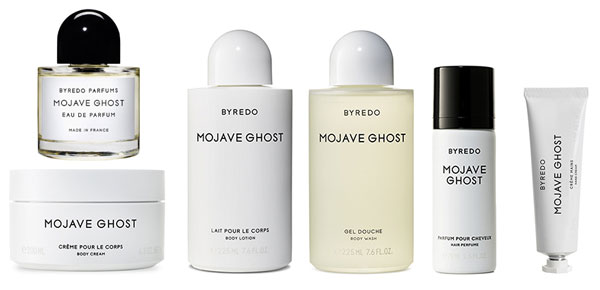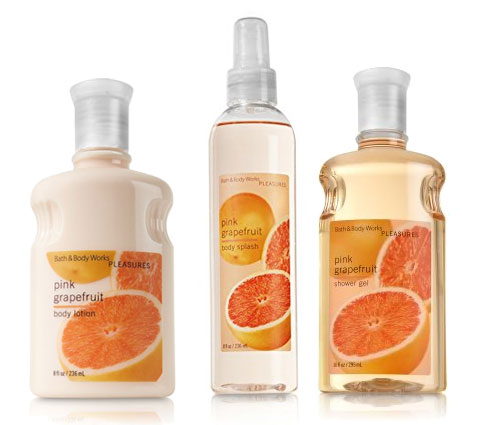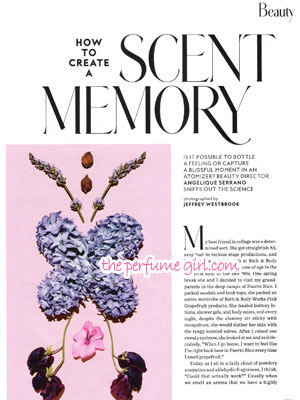Create a Scent Memory
Create a Scent Memory
In this month's InStyle magazine, beauty editor Angelique Serrano dives into the science behind memories triggered by scents to discover if it's possible to consciously create your own scent memory.
Excerpts from a fragrance editorial, How to Create a Scent Memory, in InStyle Magazine, September 2016 issue.

How to Create a Scent Memory
-- Angelique Serrano, Beauty Director InStyle | Read more @ InStyle.com
Is it possible to bottle a feeling or capture a blissful moment in an atomizer? Beauty director Angelique Serrano sniffs out the science.
"My best friend in college was a determined sort. She got straight A's, sang lead in various stage productions, and held down a part-time job at Bath & Body Works - a dream gig if you came of age in the Plumeria haze of the late '90s. One spring break she and I decided to visit my grandparents in the deep campo of Puerto Rico. I packed sandals and tank tops; she packed an entire wardrobe of Bath & Body Works Pink Grapefruit products. She hauled buttery lotion, shower gels, and body mists, and every night, despite the clammy air sticky with mosquitoes, she would slather her skin with the tangy scented salves. After I raised one sweaty eyebrow, she looked at me and said decisively, "When I go home, I want to feel like I'm right back here in Puerto Rico every time I smell graprefrui."
Today, as I sit in a daily cloud of powdery cosmetics and aldehydic fragrances, I think, "Could that actually work?" Usually when we smell an aroma that we have a highly emotional response to, it's involuntary, an automatic reflex we can no more easily stop than a sneeze. ... But... Could you actively, consciously take part in creating a visceral emotional response to a scent?
With these questions in mind, I reached out to a few acclaimed perfumers. They mused that is just might be possible, but they weren't exactly sure how to go about it. So I bounced some ideas off Pamela Dalton, a cognitive psychologist and olfactory researcher at Philadelphia's Monell Chemical Senses Center. "We've actually done work in this field," she says, assuring me that my college roommate was on to something. "You take a scent that's truly novel to a person, expose them to it when they're having an experience - pleasurable or not - and you'll be able to condition the person to return to the emotional state they were in upon smelling the scent." ...here's just how to do it.
Follow Your Nose
The first step in creating a scent memory may be the hardest: Find an aroma that you've never smelled before. "Novelty is important because we know from memory research that certain entities can hold [only] so much association power," explains Dr. Dalton. So skip the stuff you regularly take in or can easily identify... When searching for a new blend, stroll through a fragrance boutique and seek out niche brands like Byredo, Frederic Malle, or Le Labo. Or consider browsing through a shop that sells natural oils and then inhaling less common notes, like herbaceous eucalyptus or sage. Once you land on a foreign-enough scent that actually appeals to you, look for it in different forms. Can you find it in its natural state? Can you buy it as an oil? How about a perfume or candle? The more legs it has, the better.
Have a Moment
Identify an upcoming event or situation you'd like to be able to relive - just make sure it's an evocative one. "The strength of the conditioning does seem to rest on how emotional the experience is and the intensity of those emotions," says Dr. Dalton. Perhaps your wedding is approaching, or maybe you're dating someone new and always want to remember that season when you fell crazy in love. Whatever the situation, mark the time and prepare.
Distribute the Scent
Organize your ancillaries: If you have the scent in its natural botanical state (say, dried sage leaves), make your own sachets by tucking the bits into mesh pouches. Get as many oils, lotions, and powders as you can find. It your chosen moment is an upcoming trip, stach the sachets in your suitcases, then zip them up and tuck them away. You don't was to wear or smell the notes so much in advance of the experience you're trying to capture that you actually start adapting to them, says Dr. Dalton.
Layer It On
When the time comes - whether it's your wedding day, a vacation getaway, or quality time with your love - start exposing yourself to the scent. Light an aromatic candle in your space. Shower with your perfumed gel. Apply a cream or lotion in the morning, then again at night. The more days you can do this, the better, as "forming an odor association to a pleasant event takes a few more pairings than it would with a negative event," says Dr. Dalton.
Get Some Distance
When the occassion draws to an end, snuff out the candles and put away the perfumes. Try getting a good few months to clear your mind. Then you can take out the scent trigger and let the floodgates open. Just resist the urge to traipse down memory lane every other night. If you get the occassional hit - about once or twice a year, suggests Dr. Dalton - the scent will retain its precious power.

Byredo Mojave Ghost
Collect Them All - Top-selliing perfumes have the most ancillary products (shower gels, soaps, and even hair mists). Sniff out niche brands like BYREDO to discover a scent that just might be new to you and then go full nostril.
Byredo Mojave Ghost Eau de Parfum ($150/1.7 oz.), Body Wash ($50), Lotion ($65), Roll-On Perfume Oil ($78), Soap Bar ($30), Hand Cream ($35), Hair Perfume ($62), and Body Cream ($94); byredo.com.
(Serrano, Angelique. "Beauty: How to Create a Scent Memory." InStyle Sept. 2016: 327-330)
Photo of Angelique Serrano © InStyle



